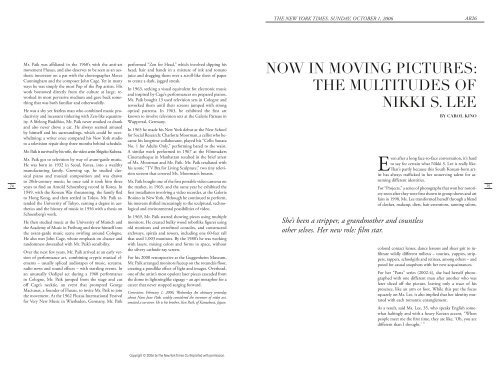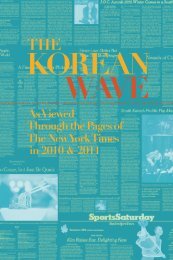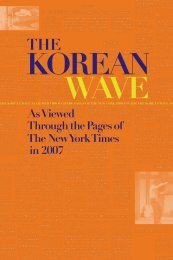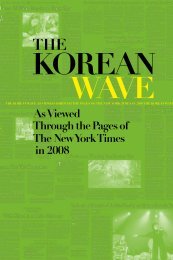The Korean Wave 2006 - Korean Cultural Service
The Korean Wave 2006 - Korean Cultural Service
The Korean Wave 2006 - Korean Cultural Service
Create successful ePaper yourself
Turn your PDF publications into a flip-book with our unique Google optimized e-Paper software.
<strong>The</strong> New York Times, sunday, october 1, <strong>2006</strong><br />
AR26<br />
74<br />
Mr. Paik was affiliated in the 1960’s with the anti-art<br />
movement Fluxus, and also deserves to be seen as an aesthetic<br />
innovator on a par with the choreographer Merce<br />
Cunningham and the composer John Cage. Yet in many<br />
ways he was simply the most Pop of the Pop artists. His<br />
work borrowed directly from the culture at large, reworked<br />
its most pervasive medium and gave back something<br />
that was both familiar and otherworldly.<br />
He was a shy yet fearless man who combined manic productivity<br />
and incessant tinkering with Zen-like equanimity.<br />
A lifelong Buddhist, Mr. Paik never smoked or drank<br />
and also never drove a car. He always seemed amused<br />
by himself and his surroundings, which could be overwhelming:<br />
a writer once compared his New York studio<br />
to a television repair shop three months behind schedule.<br />
Mr. Paik is survived by his wife, the video artist Shigeko Kubota.<br />
Mr. Paik got to television by way of avant-garde music.<br />
He was born in 1932 in Seoul, Korea, into a wealthy<br />
manufacturing family. Growing up, he studied classical<br />
piano and musical composition and was drawn<br />
to 20th-century music; he once said it took him three<br />
years to find an Arnold Schoenberg record in Korea. In<br />
1949, with the <strong>Korean</strong> War threatening, the family fled<br />
to Hong Kong, and then settled in Tokyo. Mr. Paik attended<br />
the University of Tokyo, earning a degree in aesthetics<br />
and the history of music in 1956 with a thesis on<br />
Schoenberg’s work.<br />
He then studied music at the University of Munich and<br />
the Academy of Music in Freiburg and threw himself into<br />
the avant-garde music scene swirling around Cologne.<br />
He also met John Cage, whose emphasis on chance and<br />
randomness dovetailed with Mr. Paik’s sensibility.<br />
Over the next few years, Mr. Paik arrived at an early version<br />
of performance art, combining cryptic musical elements<br />
– usually spliced audiotapes of music, screams,<br />
radio news and sound effects – with startling events. In<br />
an unusually Oedipal act during a 1960 performance<br />
in Cologne, Mr. Paik jumped from the stage and cut<br />
off Cage’s necktie, an event that prompted George<br />
Maciunas, a founder of Fluxus, to invite Mr. Paik to join<br />
the movement. At the 1962 Fluxus International Festival<br />
for Very New Music in Wiesbaden, Germany, Mr. Paik<br />
performed “Zen for Head,” which involved dipping his<br />
head, hair and hands in a mixture of ink and tomato<br />
juice and dragging them over a scroll-like sheet of paper<br />
to create a dark, jagged streak.<br />
In 1963, seeking a visual equivalent for electronic music<br />
and inspired by Cage’s performances on prepared pianos,<br />
Mr. Paik bought 13 used television sets in Cologne and<br />
reworked them until their screens jumped with strong<br />
optical patterns. In 1963, he exhibited the first art<br />
known to involve television sets at the Galerie Parnass in<br />
Wuppertal, Germany.<br />
In 1965 he made his New York debut at the New School<br />
for Social Research: Charlotte Moorman, a cellist who became<br />
his longtime collaborator, played his “Cello Sonata<br />
No. 1 for Adults Only,” performing bared to the waist.<br />
A similar work performed in 1967 at the Filmmakers<br />
Cinematheque in Manhattan resulted in the brief arrest<br />
of Ms. Moorman and Mr. Paik. Mr. Paik retaliated with<br />
his iconic “TV Bra for Living Sculpture,” two tiny television<br />
screens that covered Ms. Moorman’s breasts.<br />
Mr. Paik bought one of the first portable video cameras on<br />
the market, in 1965, and the same year he exhibited the<br />
first installation involving a video recorder, at the Galeria<br />
Bonino in New York. Although he continued to perform,<br />
his interests shifted increasingly to the sculptural, technological<br />
and environmental possibilities of video.<br />
In 1969, Mr. Paik started showing pieces using multiple<br />
monitors. He created bulky wood robotlike figures using<br />
old monitors and retrofitted consoles, and constructed<br />
archways, spirals and towers, including one 60-feet tall<br />
that used 1,003 monitors. By the 1980’s he was working<br />
with lasers, mixing colors and forms in space, without<br />
the silvery cathode-ray screen.<br />
For his 2000 retrospective at the Guggenheim Museum,<br />
Mr. Paik arranged monitors faceup on the rotunda’s floor,<br />
creating a pondlike effect of light and images. Overhead,<br />
one of the artist’s most opulent laser pieces cascaded from<br />
the dome in lightninglike zigzags – an apt metaphor for a<br />
career that never stopped surging forward.<br />
Correction: February 1, <strong>2006</strong>, Wednesday An obituary yesterday<br />
about Nam June Paik, widely considered the inventor of video art,<br />
omitted a survivor. He is his brother, Ken Paik, of Kamakura, Japan.<br />
Now in Moving Pictures:<br />
<strong>The</strong> Multitudes of<br />
Nikki S. Lee<br />
She’s been a stripper, a grandmother and countless<br />
other selves. Her new role: film star.<br />
By CAROL KINO<br />
Even after a long face-to-face conversation, it’s hard<br />
to say for certain what Nikki S. Lee is really like.<br />
That’s partly because this South <strong>Korean</strong>-born artist<br />
has always trafficked in her unnerving talent for assuming<br />
different identities.<br />
For “Projects,” a series of photographs that won her notoriety<br />
soon after they were first shown in group shows and art<br />
fairs in 1998, Ms. Lee transformed herself through a blend<br />
of clothes, makeup, diets, hair extensions, tanning salons,<br />
colored contact lenses, dance lessons and sheer grit to infiltrate<br />
wildly different milieus – tourists, yuppies, strippers,<br />
rappers, schoolgirls and retirees, among others – and<br />
posed for casual snapshots with her new acquaintances.<br />
For her “Parts” series (2002-4), she had herself photographed<br />
with one different man after another who was<br />
later sliced off the picture, leaving only a trace of his<br />
presence, like an arm or foot. While this put the focus<br />
squarely on Ms. Lee, it also implied that her identity mutated<br />
with each romantic entanglement.<br />
As a result, said Ms. Lee, 35, who speaks English somewhat<br />
haltingly and with a heavy <strong>Korean</strong> accent, “When<br />
people meet me the first time, they are like, ‘Oh, you are<br />
different than I thought.’ ”<br />
75<br />
Copyright © <strong>2006</strong> by <strong>The</strong> New York Times Co. Reprinted with permission.





